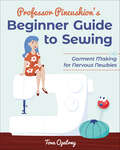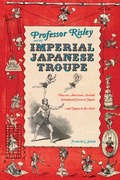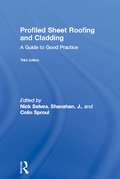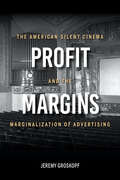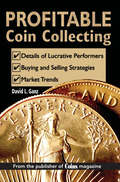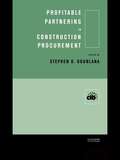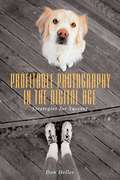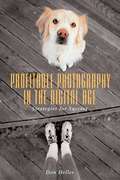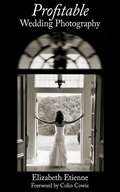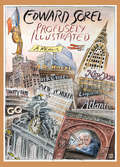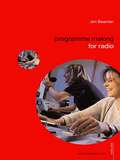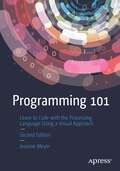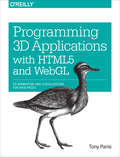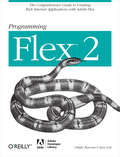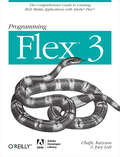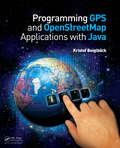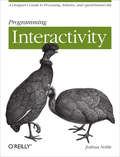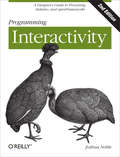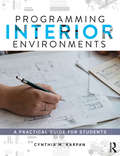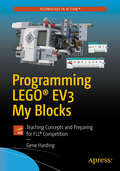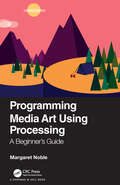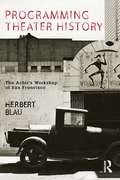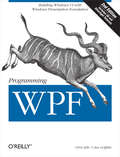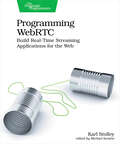- Table View
- List View
Professor Jonathan T. Buck's Mysterious Airship Notebook: The Lost Step-by-Step Schematic Drawings from the Pioneer of Steampunk Design
by Keith Riegert Samuel Kaplan Jonathan BuckPART STEP-BY-STEP HOW-TO-DRAW GUIDE, PART THRILLING STEAMPUNK ADVENTURE STORYAt the end of the 19th century, a brilliant inventor, Professor Jonathan T. Buck, crafted a beautiful steam-powered airship for an expedition to South America's Amazon River Basin in search of a magnificent lost city -- hidden from terrestrial explorers for centuries by its surrounding dense forests.But something mysterious happened in the heart of the jungle -- Buck, his crew and the Air Paddle Steamer Claire vanished.More than a century later, an expedition sent to look for any trace of the Claire vanished and its crew discovered a single, discarded trunk lodged high in the forest canopy. Inside was this notebook: a riveting -- firsthand account that reveals not only just how Buck drew up the plans for his airship, but what fate befell the expedition.Professor Jonathan T. Buck's Mysterious Airship Notebook is unlike any adventure story before. Part drawing guide, part historical saga, this book will transport readers to a world before modern technology, when steam power, gadgets, gases and gizmos took us into the skies.
Professor Pincushion's Beginner Guide to Sewing: Garment Making for Nervous Newbies
by Tova OpatrnyStart sewing in no time with the basics broken down to the simplest form and five key garment projects to build up your skills and confidence.Professor Pincushion’s Beginner Guide to Sewing is part textbook, part how-to, and all cheeky fun. Perfect for anyone interested in learning how to make clothes, the book assumes the reader has no sewing experience and breaks everything down to its simplest form, making it easy for anyone to follow along. In typical Professor Pincushion style, the tone is lightened with humor to provide an enjoyable learning experience. Beginning with an overview of sewing tools and supplies, she covers topics like using a sewing machine, reading commercial patterns, and basic garment sewing techniques and gives you five projects to get you started. Accompanying videos further illustrate the how-to concepts.“What a wonderful introduction for the new sewist, offering everything readers could want to know in an attractive graphic presentation . . . The clear instructions, attractive photos, and graphics make this an essential starting place for sewing and a foundation to continue to build on.” —Library Journal (starred review)
Professor Risley and the Imperial Japanese Troupe
by Frederik L. Schodt"Frederik L. Schodt has at long last unveiled the fascinating story of 'Professor Risley.' Circus scholars, history buffs, and anyone with an ounce of curiosity should be grateful to him."--Dominique Jando, Circopedia.org "Professor" Risley (Richard Risley Carlisle) introduced the Western circus to Japan in 1864. Three years later, this former acrobat gave many in the West their first glimpse of Japan when he took his "Imperial Japanese Troupe" of acrobats and jugglers on a triumphant tour of North America and Europe. Over the next few years, the Troupe performed before presidents, monarchs, and ordinary citizens. Frederik L. Schodt argues compellingly that such early popular entertainments helped stir a curiosity about all things Japanese that eventually led to japonisme, The Mikado, and, in our time, the boom in manga and anime. Schodt's depiction of Risley and his troupe is enlivened by portraits of the circus demimonde and supported by nineteenth-century photographs, posters, and drawings, many in color. His accounts of these first meetings between Westerners and Japanese shed new light on how different cultures meet, mingle, and influence each other. Descriptions of crowds, dazzling routines, and superstar troupe performers like the famous Little All Right are a delightful revelation to anyone interested in Asia, the circus, and popular entertainment. Frederik L. Schodt has authored numerous books about Japan, including Manga! Manga! and Native American in the Land of the Shogun. In 2009 for his work he was awarded the Order of the Rising Sun, Gold Rays with Rosette.
Profiled Sheet Roofing and Cladding: A Guide to Good Practice
by N. W. SelvesThis guide, the third edition of the NFRCs guide to good practice, is an accessible and practical code of practice in the application, design and installation of profiled sheeting and wall and roof cladding. The UK has developed very cost-effective methods of erecting and cladding factory, warehouse and storage buildings. This book distills the knowledge of many of the leading experts in this area of construction with hands-on site experience.Profiled Sheet Roofing and Cladding, Third edition sets out principles whereby all necessary components can be successfully integrated to provide a weather-tight external envelope that meets all the required performance standards. The special requirements of insulated structures are also considered. It gives up-to-date advice and information which takes account of the exceptional requirements specified and the consequent developments which have occured since the second edition was published in 1991. Written for all construction professionals concerned with getting the best value solution for their profiled sheet clad buildings, the guide aims to assist in increasing cooperation between the designer and contractor and to inform all members of the building team about the abilities and applications of products.
Profit Margins: The American Silent Cinema and the Marginalization of Advertising
by Jeremy GroskopfBetween the advent of print advertising and the dawn of radio came cinema ads. These ads, aimed at a captive theater audience, became a symbol of the developing binary between upper-class film consumption and more consumerist media.In Profit Margins, Jeremy Groskopf examines how the ad industry jockeyed for direct advertisement space in American motion pictures. In fact, advertisers, who recognized the import of film audiences, fought exhibitors over what audiences expected in a theater outing. Looking back at these debates in four case studies, Groskopf reveals that advertising became a marker of class distinctions in the cinema experience as the film industry pushed out advertisers in order to create a space free of ads. By restricting advertising, especially during the rise of high-class, palatial theaters, the film industry continued its ongoing effort to ascend the cultural hierarchy of the arts. An important read for film studies and the history of marketing, Profit Margins exposes the fascinating truth surrounding the invention of cinema advertising techniques and the resulting rhetoric of class division.
Profitable Coin Collecting
by David L GanzThere's no mistaking the purpose of this book, or the opportunities it may provide you with. This reference contains deep market analysis of popular rare U.S. coins minted in the last century, with advice and alternative collecting and investing options for you to use, plus answers to common collecting questions and concerns including: How do you start investing coins? Which types of coins are the easiest to buy and sell? What coins have become top performers in collecting over the last 50 years? This book breaks down coin collecting into understandable and applicable steps that can lead to lucrative investments.
Profitable Partnering in Construction Procurement
by Stephen O. OgunlanaProfitable Partnering in Construction Procurement is a compilation of papers presented at the CIB W92 Symposium held in Chaing Mai, Thailand in January 1999. This volume, drawing on contributions from leading experts in construction contract procurement from 22 countries, addresses the issues of culture within organisations and national cultures and their impact on procurement, performance and profitability.Substantial coverage is given to private finance projects, privatised infrastructure projects, contractor selection and prequalification, decision support systems for procurement, management of design, contracts and contract documents, sustainable construction and the performance of procurement systems.Profitable Partnering in Construction Procurement is a reference for construction professionals and researchers, contract administrators and lawyers wishing to gain an understanding of the complex issues of harmony and profit in construction procurement.
Profitable Photography in Digital Age: Strategies for Success
by Dan HellerThis groundbreaking resource demonstrates how to use digital imaging and the Internet as the cornerstone of a successful photography business. Topics covered include setting business goals, marketing, setting prices, selling prints, running a Web-based photography business, working with stock agencies, legally protecting images, and more. Both serious amateurs considering a start-up and established businesses looking for fresh approaches need this timely, relevant book.Allworth Press, an imprint of Skyhorse Publishing, publishes a broad range of books on the visual and performing arts, with emphasis on the business of art. Our titles cover subjects such as graphic design, theater, branding, fine art, photography, interior design, writing, acting, film, how to start careers, business and legal forms, business practices, and more. While we don't aspire to publish a New York Times bestseller or a national bestseller, we are deeply committed to quality books that help creative professionals succeed and thrive. We often publish in areas overlooked by other publishers and welcome the author whose expertise can help our audience of readers.
Profitable Photography in the Digital Age: Strategies for Success
by Dan HellerThis groundbreaking resource demonstrates how to use digital imaging and the Internet as the cornerstone of a successful photography business. Topics covered include setting business goals, marketing, setting prices, selling prints, running a Web-based photography business, working with stock agencies, legally protecting images, and more. Both serious amateurs considering a start-up and established businesses looking for fresh approaches need this timely, relevant book.
Profitable Wedding Photography
by Elizabeth Etienne Colin CowieNow aspiring wedding photographers have a comprehensive guide to building a profitable wedding business! Drawing from her twenty-three years of experience in the wedding photography industry, author Elizabeth Etienne helps readers reduce the growing pains both in shooting a wedding and in dealing with wedding clients. Unique features include prep sheets such as: couple's questionnaire, shot list, photo timeline, helpful hints, contract, and package rate sheet. With an introduction written by celebrity wedding planner Colin Cowie, this indispensable book will teach you how to: - Create a great product - Offer dynamic customer service - Price your product and service appropriately - Package your product uniquely - Market your product effectively. Anyone looking for practical advice on how to start and grow a wedding business will need this one-stop resource from one of the most sought after wedding photographers in the world.
Profusely Illustrated: A Memoir
by Edward SorelThe fabulous life and times of one of our wittiest, most endearing and enduring caricaturists—in his own words and inimitable art. Sorel has given us "some of the best pictorial satire of our time ... [his] pen can slash as well as any sword&” (The Washington Post).Alongside more than 172 of his drawings, cartoons, and caricatures—and in prose as spirited and wickedly pointed as his artwork—Edward Sorel gives us an unforgettable self-portrait: his poor Depression-era childhood in the Bronx (surrounded by loving Romanian immigrant grandparents and a clan of mostly left-leaning aunts and uncles); his first stabs at drawing when pneumonia kept him out of school at age eight; his time as a student at New York&’s famed High School of Music and Art; the scrappy early days of Push Pin Studios, founded with fellow Cooper Union alums Milton Glaser and Seymour Chwast, which became the hottest design group of the 1960s; his two marriages and four children; and his many friends in New York&’s art and literary circles. As the &“young lefty&” becomes an &“old lefty,&” Sorel charts the highlights of his remarkable life, by both telling us and showing us how in magazines and newspapers, books, murals, cartoons, and comic strips, he steadily lampooned—and celebrated—American cultural and political life. He sets his story in the parallel trajectory of American presidents, from FDR&’s time to the present day—with the candor and depth of insight that could come only from someone who lived through it all. In Profusely Illustrated, Sorel reveals the kaleidoscopic ways in which the personal and political collide in art—a collision that is simultaneously brilliant in concept and uproarious and beautiful in its representation.
Programme Making for Radio
by Jim BeamanProgramme Making for Radio offers trainee radio broadcasters and their instructors focused practical guidelines to the professional techniques applied to the making of radio shows, explaining how specific radio programmes are made and the conventions and techniques required to produce them. This book describes how and why these methods are applied through the use of a behind-the-scenes glimpse at working practices and procedures used in the industry. It considers the constraints and incentives that limit or stimulate creativity and innovation within programme production. Programme Making for Radio examines the individual roles and responsibilities of the whole production team and the importance of team-working skills. Chapters focus on the specific requirements of specialist programmes and offer advice from a range of programme makers working in local and national broadcasting. There is a case study example that follows the progress of a feature programme from pitching the original idea, through assembling material to final transmission. Programme Making for Radio includes: a clear description of the role of each member of the programme making team, their duties and responsibilities practical tips on interviewing, mixing and presenting explanations of the key elements that make up a radio programme such as clips, wraps, packages, features and interviews with a full glossary of technical terms. This book is informative, accessible and comprehensive, covering the whole range of skills needed by the radio professional in the studio and on location.
Programming 101: Learn to Code with the Processing Language Using a Visual Approach
by Jeanine MeyerProgramming permeates almost all aspects of our lives. This includes being active on social media, shopping online, and participating in virtual courses. It also includes driving a car and using many devices. This book will teach you the basics of programming using the Processing programming language and provide practice with logical, algorithmic thinking. It can provide insight into what is involved in producing the technical infrastructure of our world. While reading this book, you can build programs based on your own ideas, using images you create or acquire and making connections to activities you enjoy. The chapters in the book will demonstrate the process of programming, starting with formulating an idea, planning, building on past projects, and refining the work, similar to writing an essay or composing a song. This approach will guide you to make use of logic and mathematics to produce beautiful effects. The text contains an Appendix with an introduction to p5.js, a way to produce JavaScript programs with Processing functionality for drawing, images, and interactions to publish on the Web. The term for program in Processing is sketch. The Processing language has been constructed by visual artists using the Java programming language as a base. However, the sketches featured in this book and typical in Processing are far more than static drawings; they incorporate interaction, animation, video, audio, and accessing files on the local computer and on the Web. Technical features are introduced and explained in the context of complete examples: games (Snake, Hangman, jigsaw, slingshot), making a collage of family images and video clips, preparing directions for folding an origami model, rotating objects in 3D, and others. Programming is a fun, creative, expressive pursuit. It does require attention to details and can be frustrating. Still, there is very little that compares to the satisfaction of building a program out of nothing and making it work (or taking an existing program and fixing a problem, or adding a feature and making it better). Programming 101 is your gateway to making this happen. What You'll Learn Gain basic programming skills Build fun and creative programs Use files for making a holiday card or a sequence of instructions Combine videos, images, and graphics in a Processing sketch Connections to other programming languages, most especially Java and JavaScript Who This Book Is For Anyone who has been thinking about trying programming, or has tried, but needs assistance. Anyone who wants to use their own creativity and artistic talents. Anyone who wants to know what is involved in the technology that is present in our lives. Anyone who wants to know what is involved in the technology that is present in our lives.
Programming 3D Applications with HTML5 and WebGL: 3D Animation and Visualization for Web Pages
by Tony ParisiCreate high-performance, visually stunning 3D applications for the Web, using HTML5 and related technologies such as CSS3 and WebGL—the emerging web graphics standard. With this book, you’ll learn how to use the tools, frameworks, and libraries for building 3D models and animations, mind-blowing visual effects, and advanced user interaction in both desktop and mobile browsers.In two parts—Foundations and Application Development Techniques—author Tony Parisi provides a thorough grounding in theory and practice for designing everything from a simple 3D product viewer to immersive games and interactive training systems. Ideal for developers with Javascript and HTML experience.Explore HTML5 APIs and related technologies for creating 3D web graphics, including WebGL, Canvas, and CSSWork with the popular JavaScript 3D rendering and animation libraries Three.js and Tween.jsDelve into the 3D content creation pipeline, and the modeling and animation tools for creating killer 3D contentLook into several game engines and frameworks for building 3D applications, including the author’s Vizi frameworkCreate 3D environments with multiple objects and complex interaction, using examples and supporting codeExamine the issues involved in building WebGL-based 3D applications for mobile browsers
Programming Flex 2: The Comprehensive Guide to Creating Rich Internet Applications with Adobe Flex
by Joey Lott Chafic KazounIs there an easier way to build and deliver rich internet applications (RIAs) other than the Flash IDE or Ajax? Absolutely. With Adobe Flex 2, the Flex 2 SDK, and this book, you have all you need to build RIAs. Programming Flex 2 offers you plenty of practical and useful examples that reveal how and why to use a particular feature of Flex 2, and when and when not to. As part of the Adobe Developer Library, Programming Flex 2 is the authoritative guide to this new Adobe framework. You learn to use a markup language called MXML and a vast library of off-the-shelf and highly-configurable components to build Flash-based applications that combine the immediacy of the Web with the functionality and responsiveness of desktop applications. You also discover why -- with the Flash Player runtime environment and the powerful ActionScript 3.0 programming language -- the possibilities with Flex 2 are nearly limitless. Topics include: Managing LayoutWorking with ComponentsWorking with MediaManaging StateUsing Transitions and EffectsWorking with DataCustomizing Application AppearanceClient Data Communication and Remote Data CommunicationDebugging Flex Framework ApplicationsCreating Custom Components Flex may be easier to learn than the Flash IDE, but you still need a reliable guide to the framework. Programming Flex 2 not only serves as a reference, but provides valuable and practical insight into this new technology. As you learn how to build Flex applications, you'll also discover how Flex works. This book supplies all the information you need in one convenient place. Adobe Developer Library is a co-publishing partnership between O'Reilly Media and Adobe Systems, Inc. and is designed to produce the number one information resources for developers who use Adobe technologies. Created in 2006, the Adobe Developer Library is the official source for comprehensive learning solutions to help developers create expressive and interactive web applications that can reach virtually anyone on any platform. With top-notch books and innovative online resources covering the latest in rich Internet application development, the Adobe Developer Library offers expert training and in-depth resources, straight from the source.
Programming Flex 3: The Comprehensive Guide to Creating Rich Internet Applications with Adobe Flex
by Joey Lott Chafic KazounIf you want to try your hand at developing rich Internet applications with Adobe's Flex 3, and already have experience with frameworks such as .NET or Java, this is the ideal book to get you started. Programming Flex 3 gives you a solid understanding of Flex 3's core concepts, and valuable insight into how, why, and when to use specific Flex features. Numerous examples and sample code demonstrate ways to build complete, functional applications for the Web, using the free Flex SDK, and RIAs for the desktop, using Adobe AIR. This book is an excellent companion to Adobe's Flex 3 reference documentation. With this book, you will:Learn the underlying details of the Flex frameworkProgram with MXML and ActionScriptArrange the layout and deal with UI componentsWork with mediaManage state for applications and componentsUse transitions and effectsDebug your Flex applicationsCreate custom componentsEmbed Flex applications in web browsersBuild AIR applications for the desktopFlex 3 will put you at the forefront of the RIA revolution on both the Web and the desktop. Programming Flex 3 will help you get the most from this amazing and sophisticated technology.
Programming GPS and OpenStreetMap Applications with Java: The RealObject Application Framework
by Kristof BeiglböckWritten by an expert in the development of GPS systems with digital maps and navigation, Programming GPS and OpenStreetMap Applications with Java: The RealObject Application Framework provides a concrete paradigm for object-oriented modeling and programming. It presents a thorough introduction to the use of available global positioning data for the
Programming Interactivity: A Designer's Guide to Processing, Arduino, and Openframeworks
by Joshua NobleMake cool stuff. If you're a designer or artist without a lot of programming experience, this book will teach you to work with 2D and 3D graphics, sound, physical interaction, and electronic circuitry to create all sorts of interesting and compelling experiences -- online and off.Programming Interactivity explains programming and electrical engineering basics, and introduces three freely available tools created specifically for artists and designers:Processing, a Java-based programming language and environment for building projects on the desktop, Web, or mobile phonesArduino, a system that integrates a microcomputer prototyping board, IDE, and programming language for creating your own hardware and controlsOpenFrameworks, a coding framework simplified for designers and artists, using the powerful C++ programming languageBTW, you don't have to wait until you finish the book to actually make something. You'll get working code samples you can use right away, along with the background and technical information you need to design, program, build, and troubleshoot your own projects. The cutting edge design techniques and discussions with leading artists and designers will give you the tools and inspiration to let your imagination take flight.
Programming Interactivity: A Designer's Guide to Processing, Arduino, and openFrameworks
by Joshua NobleReady to create rich interactive experiences with your artwork, designs, or prototypes? This is the ideal place to start. With this hands-on guide, you’ll explore several themes in interactive art and design—including 3D graphics, sound, physical interaction, computer vision, and geolocation—and learn the basic programming and electronics concepts you need to implement them. No previous experience is necessary.You’ll get a complete introduction to three free tools created specifically for artists and designers: the Processing programming language, the Arduino microcontroller, and the openFrameworks toolkit. You’ll also find working code samples you can use right away, along with the background and technical information you need to design, program, and build your own projects.Learn cutting-edge techniques for interaction design from leading artists and designersLet users provide input through buttons, dials, and other physical controlsProduce graphics and animation, including 3D images with OpenGLUse sounds to interact with users by providing feedback, input, or an element they can controlWork with motors, servos, and appliances to provide physical feedbackTurn a user’s gestures and movements into meaningful input, using Open CV
Programming Interior Environments: A Practical Guide for Students
by Cynthia M. KarpanProgramming Interior Environments introduces a four-component framework you can use to program interiors, and twelve methods for you to gather, analyze and synthesize programmatic information to take the guesswork out of your studio projects. This book studies the Student Programming Model: a realistic programming process for college and university interior design students that allows students to create accurate and in-depth programming documents essential for informing the design process. This is done whilst keeping in mind that students are often working solo, with imaginary clients and end users in mind, and collecting program information within strict time constraints. Including three appendices of student programs created following these guidelines, to help you understand how to apply the framework components and inquiry methods in your own work, this book is ideal for students and professionals in interior design and interior architecture.
Programming LEGO® EV3 My Blocks: Teaching Concepts And Preparing For Fll® Competition
by Gene HardingProgram Lego® My Blocks to accurately perform navigation functions on competition mats, such as moving forward and backward quickly and precisely, turning, following walls, and following lines. This book features extensive illustrations help to bring each step and concept to life so that you can easily follow along. You'll start by moving your creations forward and backward accurate distances while maintaining directional accuracy. You'll then build My Blocks to turn left and right at precise angles. After that you’re creations will be ready to find, follow, and otherwise use lines on the mat to improve navigation accuracy. Finally, you'll delve into using game board border walls to navigate and advanced topics, such as handoffs at speed and accelerating/decelerating to enable higher speed while maintaining navigation accuracy.This book addresses EV3 programming in the specific context of FLL® competition. With Programming Lego® EV3 My Blocks, you will be game-ready to manage the season, prepare for competition, and compete!What You'll Learn Construct and use My Blocks to improve robot performance in the FLL® Robot Game Develop basic programming skills, including feedback, troubleshooting techniques, and unit conversion Comment programs appropriately to note errors and consistencyWho This Book Is For The book is targeted at the many FLL® coaches, mentors, and students who need help with programming the EV3, as well as the students they coach. A secondary audience is teachers who want to use the EV3 to teach programming concepts.
Programming Media Art Using Processing: A Beginner's Guide
by Margaret NobleProgramming Media Art Using Processing: A Beginner's Guide provides an entry-level exploration into visual design through computer programming using the open source and artist-friendly language, Processing. Used by hundreds of students, this learning system breaks lessons down into strategic steps towards fun and creative media art projects. This book provides a linear series of lessons with step-by-step examples that lead to beginning media art projects, including abstract designs, pixel landscapes, rollover animations, and simple video games. Computer programming can be overwhelming for the first-time learner, but this book makes the learning of code more digestible and fun through a full color, well-diagrammed, and deeply explained text presentation. Lessons are rhythmically broken down into digestible parts with code annotations and illustrations that help learners focus on the details one step at a time. The content is legible, flexible, and fun to work with because of its project-based nature. By following the lessons and producing the projects sequentially in this book, readers will develop the beginning foundational skills needed to understand computer programming basics across many languages and also explore the art of graphic design. Ultimately, this is a hands-on, practical guide.
Programming Theater History: The Actor's Workshop of San Francisco
by Herbert Blau‘One of the great stories of the American theater..., the Workshop not only built an international reputation with its daring choice of plays and nontraditional productions, it also helped launch a movement of regional, or resident, companies that would change forever how Americans thought about and consumed theater.’ – Elin Diamond, from the Introduction Herbert Blau founded, with Jules Irving, the legendary Actor's Workshop of San Francisco, in 1952, starting with ten people in a loft above a judo academy. Over the course of the next 13 years and its hundred or so productions, it introduced American audiences to plays by Brecht, Beckett, Pinter, Genet, Arden, Fornes, and various unknown others. Most of the productions were accompanied by a stunningly concise and often provocative programme note by Blau. These documents now comprise, within their compelling perspective, a critique of the modern theatre. They vividly reveal what these now canonical works could mean, first time round, and in the context of 1950s and 60s American culture, in the shadow of the Cold War. Programming Theater History curates these notes, with a selection of the Workshop's incrementally artful, alluring programme covers, Blau's recollections, and evocative production photographs, into a narrative of indispensable artefacts and observations. The result is an inspiring testimony by a giant of American performance theory and practice, and a unique reflection of what it is to create theatre history in the present.
Programming WPF: Building Windows UI with Windows Presentation Foundation
by Chris Sells Ian GriffithsIf you want to build applications that take full advantage of Windows Vista's new user interface capabilities, you need to learn Microsoft's Windows Presentation Foundation (WPF). This new edition, fully updated for the official release of .NET 3.0, is designed to get you up to speed on this technology quickly. By page 2, you'll be writing a simple WPF application. By the end of Chapter 1, you'll have taken a complete tour of WPF and its major elements. WPF is the new presentation framework for Windows Vista that also works with Windows XP. It's a cornucopia of new technologies, which includes a new graphics engine that supports 3-D graphics, animation, and more; an XML-based markup language, called XAML, for declaring the structure of your Windows UI; and a radical new model for controls. This second edition includes new chapters on printing, XPS, 3-D, navigation, text and documents, along with a new appendix that covers Microsoft's new WPF/E platform for delivering richer UI through standard web browsers -- much like Adobe Flash. Content from the first edition has been significantly expanded and modified. Programming WPF includes: Scores of C# and XAML examples that show you what it takes to get a WPF application up and running, from a simple "Hello, Avalon" program to a tic-tac-toe gameInsightful discussions of the powerful new programming styles that WPF brings to Windows development, especially its new model for controlsA color insert to better illustrate WPF support for 3-D, color, and other graphics effectsA tutorial on XAML, the new HTML-like markup language for declaring Windows UIAn explanation and comparison of the features that support interoperability with Windows Forms and other Windows legacy applications WPF represents the best of the control-based Windows world and the content-based web world. Programming WPF helps you bring it all together.
Programming WebRTC
by Karl StolleyBuild your own video chat application - but that's just the beginning. With WebRTC, you'll create real-time applications to stream any kind of user media and data directly from one browser to another, all built on familiar HTML, CSS, and JavaScript. Power real-time activities like text-based chats, secure peer-to-peer file transfers, collaborative brainstorming sessions - even multiplayer gaming. And you're not limited to two connected users: an entire chapter of the book is devoted to engineering multipeer WebRTC apps that let groups of people communicate in real time. You'll create your own video conferencing app. It's all here. WebRTC is an API exposed in all modern web browsers. After almost a decade of development, the WebRTC specification was finalized, and this book provides faithful coverage of that finalized specification. You'll start by building a basic but complete WebRTC application for video chatting. Chapter by chapter, you'll refine that app and its core logic to spin up new and exciting WebRTC-powered apps that will have your users sharing all manner of data with one another, all in real time. No third-party libraries or heavy downloads are required for you or your users: you'll be writing and strengthening your knowledge of vanilla JavaScript and native browser APIs.You'll learn how to directly connect multiple browsers over the open internet using a signaling channel. You will gain familiarity with a whole set of Web APIs whose features bring WebRTC to life: requesting access to users' cameras and microphones; accessing and manipulating arbitrary user files, right in the browser; and web storage for persisting shared data over the life of a WebRTC call. Like any Web API, WebRTC doesn't enjoy a perfect implementation in any browser. But this book will guide you in writing elegant code to the specification, with backward-compatible fallback code for use in almost all modern browsers.Use WebRTC to build the next generation of web applications that stream media and data in real time, directly from one user to another - all by working in the browser.What You Need:Readers need a text editor, an up-to-date copy of Chrome or Firefox, and a POSIX-style command-line shell. They'll also need to install a little bit of open-source software, especially Node.js. All necessary setup is covered in full in the book's introductory chapter.

